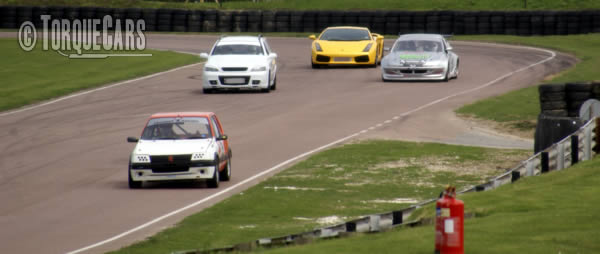Track day driving tips.
"The Top 10 Driving wind ups."
Many tracks offer beginners track days to enable the novice to enjoy a track day without winding up the seasoned track day drivers. Don't ever feel pressured to push the car too hard until your confidence builds up.
You will typically have no insurance cover for trackday driving and a mistake can be rather costly! Here are a few track day tips passed on from some regular track day drivers.
Full acceleration wastes fuel at low revs. The accelerator controls directly the amount of fuel going into the engine. 2/3 throttle will give good acceleration and a lot more fuel economy. When the revs climb up the engine will burn extra fuel more efficiently and will respond with more power. Keeping a light throttle will also help your fast take of – a spinning wheel is not going to give you more forward momentum.
 Tyre pressure.
Tyre pressure.
Tire pressures always increase as the tyre warms up – do not inflate them to the maximum pressure if your going to do a track day. You will need more pressure than the lowest recommended setting initially but you must remember to check pressure again with warm tyres to avoid a burst.
Braking - lots of heavy braking will generate loads of heat in the whole braking system – most track day accidents occur when breaks overheat and fail. Brake hard early on – feel for stopping power before relying on the brake to slow the car – if the brakes are ok ease off a little if they fail you have a bit more space for slowing the car up through engine braking. Cadence breaking hard soft hard soft is recommended for emergency stops on cars with no ABS.
Use a synthetic brake fluid (DOT 5 or better) and high quality braided hoses.
You know your car but the surface condition of the track will dramatically alter the control you have over your car. Build up speed when you are used to the track surface. Things to remember are the amount of camber, bumps, gravel and loose chippings and obviously patches of oil or water.
Run and warm the engine but do not run on a track with a hot engine, if the cooling is not working and the temperature is rising then driving hard will cause serious engine problems. A track day will put a lot of strain of the car and reduce the cars life by about 2 years.
Change the oil before and after ensuring that the level is just on the max mark and recheck half way through the track day when the car has cooled off at lunchtime.
Cornering – the exit speed is what gives you the advantage – so slow up early and accelerate through the corner on a trailing throttle building up power and speed toward the exit vector.
Get used to the front rear balance of your car and keep the cars weight evenly distributed towards the outer front and rear tyres. If there is too much weight toward the front a little throttle can help balance things up and if the rear is becoming overloaded then lifting of or very gentle breaking will help.

Stability - keep windows and sunroof closed (and the Bonnet, Doors and Boot should also be closed) when driving at high speed as these can dramatically affect the handling of the car. Tyres (pattern and tread) should be equal with a bias of more tread depth to the rear if they are uneven. Tyres should never be mixed on the same axle and preferably on the whole car always keep to the same make. Regular swapping of the tyres will help to even out the wear so that the tyres wear out at the same rate.
Fuel - most drivers run with higher octane fuel for track days - it's worth filling up and using high octane fuel a week before and get the car computer used to running with it (especially in cars that have self adjusting timing).
Although you are having fun - keep an eye on the fuel gauge as it will go down a lot faster than normal when you start driving at the edge. Your overall MPG on track may be as low as 5 mpg and it is really embarrassing when you run out of fuel! (Not to mention the sheer waste of lost track time!)
Always keep a small can of fuel handy just in case - at least you can drive to the petrol station when you run out!
If you liked this page please share it with your friends, drop a link to it in your favourite forum or use the bookmarking options to save it to your social media profile.
Check out TorqueCars new YouTube channel, and see their awesome new content...
Feedback
Please use our forums if you wish to ask a tuning question, and please note we do not sell parts or services, we are just an online magazine.
Help us improve, leave a suggestion or tip

